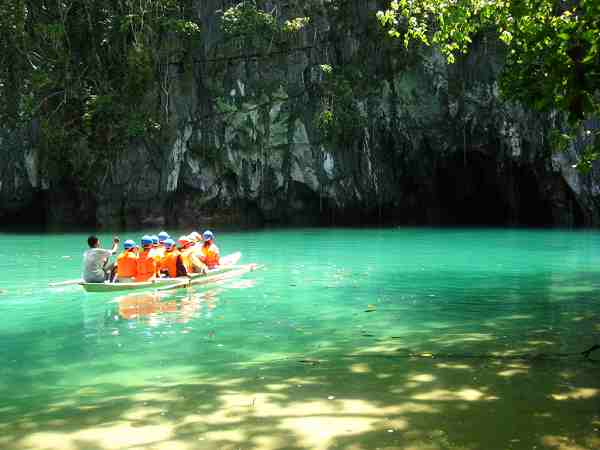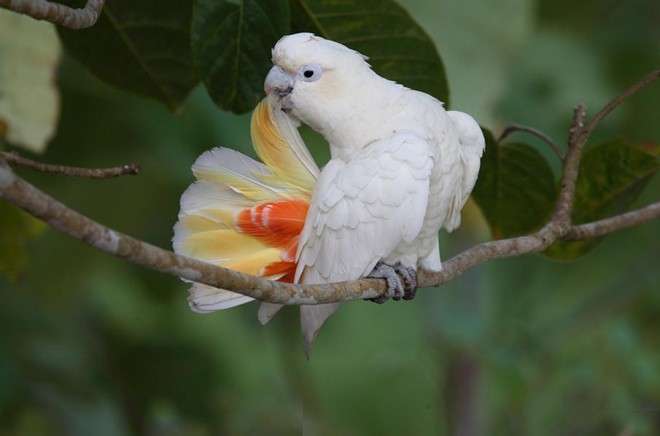Double protection at last for Palawan’s protected areas

Among the Unesco World Heritage Sites is the Puerto Princesa Subterranean Park. ROGER PE
Semirara’s photos taken from space look bizarre. Defaced, the island looks like a geological Frankenstein, grotesquely scarred by coal mining pits.
How would you feel if the same thing happens to the Last Frontier? Indignation, outrage, fury, anger, unless you can’t see.
Would you just sit there and watch the unabated environmental plunder?
At the foot of Mt. Mantalinggahan, Palawan’s highest peak, are hectares and hectares of forest trees, breathing life to one of the most diverse flora and fauna species in the world. Imagine if they are burnt to ashes to give way to palm oil plantations?
Picture endemic animals fleeing from wildfires as their habitats are razed to the ground. Imagine if the already endangered “Pilandok”(Mouse Deer), “Tandikan” (Pheasant Peacock), “Balintong” (Armadillo), “Kiyaw” (Mynah), “Pikoy” (Blue-Naped Parrot), “Katala” (Cockatoo), “Binturong” (Bear Cat) and many more continue to diminish in number. Can we all withstand the horrific sight?
Article continues after this advertisementIndonesia’s recent forest inferno can also happen in Palawan. We all know the catastrophic effect: the health-damaging haze can blanket an entire town and spread across the country.
Article continues after this advertisement
Diminishing residents of Malampaya Sound, Philippines’ richest fishing ground. ROGER PE
Can the impending environmental apocalypse happen? No, if we are doubly vigilant. No, if we are wide-awake and say yes to doubly protecting Palawan’s protected areas from further damage.
Case-in-point: West Papua. Last October, the Indonesian paradise with stunning rainforests and the world’s epicenter of marine biodiversity, boasting more species than anywhere else on the planet, became the world’s first conservation province by declaring it as a “conservation area.”
Symbolically important, it sealed the future of the province’s irreplaceable ecosystems.
“The honor could have been owned by the province of Palawan, but sadly, people who profess love for the province just pay lip service to it. They are busy milking our natural resources not knowing that someday they will all be depleted,” says Art Ventura, an environmentalist by heart and former director of Palawan Council for Sustainable Development (PCSD).
Coral Triangle, the environmental bible says of the West Papua move: “It created a legal framework for conservation efforts in one of Indonesia’s most beautiful regions, a role model for more effective conservation efforts.” The bold vision was initiated upon consultation with the provincial governor, Abraham Atururi.
Conserve Palawan now
Concerns about Palawan’s natural resources continue to surface. On social media, the sentiment is becoming more pronounced.
The deletion of five important Palawan protected areas (El Nido Managed Resource Protected Area, Malampaya Sound Protected Landscape and Seascape, Mt. Mantalinggahan Protected Landscape, Puerto Princesa Subterranean River Park and Rasa Island Wild Sanctuary) from the expanded Nipas (National Integrated Protected Areas System) house bill sparked a heated debate, prompting many concerned citizens and environmentalists to question the motives of those responsible for the act.

The breathtaking El Nido Protected Park. ROGER PE
El Nido was recently voted as World’s Best Island by Conde Nast Travel Magazine for the second consecutive year. Malampaya Sound is the Philippines’ richest fishing ground.
Mount Mantalinggahan is a vast mountain range that covers four towns. It is home to indigenous Palaw’ans and one of 11 important bird areas in the province, as well as one of only 10 sites of the Alliance for Zero Extinction sites where various species are in imminent danger of disappearing in the Philippines.
Puerto Princesa’s Subterranean Park, a Unesco World Heritage site and one of the world’s seven wonders of nature, is where the Underground River flows.
Rasa Island is home to the Philippine cockatoo, now facing extinction with only around 1,000 remain. The island, of all places, has been chosen for a coal-fired power plant.
Expanded Nipas Law
For the benefit of the uninitiated, the reinforced Nipas is a congressional bill under Republic Act 7586, which aims to replace, expand and strengthen the 23-year-old Nipas Law. Once enacted into law by Congress, it will provide greater protection for the environment, especially protected areas in the Philippines.
In Congress’ executive committee meeting held last November 11, Rep. Douglas Hagedorn of Palawan disputed the exclusion of five Palawan protected areas from the bill saying the deletion was anomalous as it did not have the committee’s approval.
Hagedorn had earlier discovered the deletion and argued that groups with ulterior motives or otherwise, can go around PCSD and open these areas to environmentally damaging activities like “regulated mining” in protected areas, an activity banned by the Enipas.

Endangered Philippine Cockatoo in Rasa Island. ROGER PE
Rep. Franz Alvarez and groups identified with Governor Jose Alvarez, however, asserted that Palawan does not need to be in the Nipas, as the province already has its own Strategic Environmental Plan (SEP) under Republic Act (RA) 7611. Governor Alvarez is currently pushing for construction of a coal-fired power plant in the province, a move being heavily opposed by environmentalist groups.
Pro-environment advocates Tony Oposa, Gina Lopez of ABS-CBN, Sonia Mendoza of Mother Earth, GerthieAnda of Environment Legal Assistance Center, Gerry Arances of Philippine Movement for Climate Justice, Dante Lagman of Sanlakas, Isagani Serrano of Philippine Rural Reconstruction Movement, Voltaire Alferez of Philippines Earth Day Network, Cynthia Sumagaysay of Palawan Alliance for Clean Energy, Jhunette Buenviaje of Greenpeace, Anne Larracas of Global Alliance of Incinerator Alternatives, Thony Dizon of Ecowaste Coalition, who were all present at the meeting disagreed.
They said inclusion of five Palawan protected areas to the expanded Nipas Law would give double protection for the province’s ecologically critical sites.
“If the Alvarezes are really interested in environmental protection and preservation as they claim to be, why object to Palawan’s double-barreled protection?” Hagedorn asserted.

Beautiful inhabitant of Mt. Mantalinggahan mountain range. R. PE
Puerto Princesa environmentalist groups also put up a united front to oppose business groups out to exploit the country’s “protected areas,” especially in Palawan.
Former Puerto Princesa City Mayor Edward Hagedorn, led the environmentalists and declared their “united and unequivocal support.”

Palawan Representative Douglas Hagedorn.
Pro-environment Senator Loren Legarda, vowed no exclusion of 5 Palawan protected areas from the rest and has also urged the committee to fast track the approval of the new Nipas.
Earlier, Puerto Princesa City Council passed an ordinance in July, declaring two coral reef sites, the Tangdol Reef in Barangay Bancao-Bancao and the Tagkuti Reef in Barangay Simpokan as “marine sanctuaries”, where any human activity, except approved scientific research, is prohibited.
Without the vigilance of Rep. Hagedorn, the House Committee on Natural Resources would have passed a bill favoring coal and non-renewable energy, mining and other business interests.
At the end of the session, five Palawan Protected Areas were restored in the original list and R. A. 7611 (Strategic Environmental Palawan) was made consistent with the new Enipas.